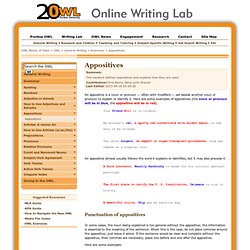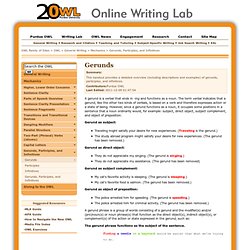

That vs. Which by Shmoop. Relative Pronouns by Shmoop. Appositives. Summary: This handout defines appositives and explains how they are used.

Contributors:Chris Berry, Dana Lynn DriscollLast Edited: 2013-04-18 03:29:26 An appositive is a noun or pronoun — often with modifiers — set beside another noun or pronoun to explain or identify it. Here are some examples of appositives (the noun or pronoun will be in blue, the appositive will be in red). Your friend Bill is in trouble. My brother's car, a sporty red convertible with bucket seats, is the envy of my friends. The chief surgeon, an expert in organ-transplant procedures, took her nephew on a hospital tour. An appositive phrase usually follows the word it explains or identifies, but it may also precede it. A bold innovator, Wassily Kandinsky is known for his colorful abstract paintings. The first state to ratify the U. A beautiful collie, Skip was my favorite dog.
Punctuation of appositives Here are some examples. The popular US president John Kennedy was known for his eloquent and inspirational speeches. Verb Tenses. Summary: This handout explains and describes the sequence of verb tenses in English.

Contributors:Chris Berry, Allen Brizee, Elizabeth AngeliLast Edited: 2013-09-14 09:29:01 Strictly speaking, in English, only two tenses are marked in the verb alone, present (as in "he sings") and past (as in "he sang"). Other English language tenses, as many as thirty of them, are marked by other words called auxiliaries. Understanding the six basic tenses allows one to re-create much of the reality of time in their writing.
Simple Present: They walk Present Perfect: They have walked Simple Past: They walked. Participles. Verb Tenses. In English, there are three basic tenses: present, past, and future.

Each has a perfect form, indicating completed action; each has a progressive form, indicating ongoing action; and each has a perfect progressive form, indicating ongoing action that will be completed at some definite time. Here is a list of examples of these tenses and their definitions: Simple Forms Present Tense Present tense expresses an unchanging, repeated, or reoccurring action or situation that exists only now. Past Tense Past tense expresses an action or situation that was started and finished in the past. Future Tense Future tense expresses an action or situation that will occur in the future.
The speaker of the House will finish her term in May of 1998. The future tense can also be expressed by using am, is, or are with going to. The surgeon is going to perform the first bypass in Minnesota. We can also use the present tense form with an adverb or adverbial phrase to show future time. The president speaks tomorrow. The Subjunctive Mood. The Subjunctive Mood Most Indo-European languages, in addition to verb tenses (which demonstrate time), have verb moods (which indicate a state of being or reality).

For instance, the most common moods in English include the indicative, the imperative, the interrogative, and the conditional. Another, rarer mood is the subjunctive mood (indicating a hypothetical state or a state contrary to reality, such as a wish, a desire, or an imaginary situation). It is harder to explain the subjunctive. Five hundred years ago, English had a highly developed subjunctive mood. 1. Parts of Speech Lesson Plan: Vary Sentence Beginnings by Utilizing the Parts of Speech. The Conjunctive Adverb. Gerunds, Participles, and Infinitives. Summary: This handout provides a detailed overview (including descriptions and examples) of gerunds, participles, and infinitives.

Contributors:Purdue OWLLast Edited: 2011-12-09 01:47:54 A gerund is a verbal that ends in -ing and functions as a noun. Grammar Web Guide. What I know about grammar is its infinite power.

To shift the structure of a sentence alters the meaning of the sentence, as definitely and inflexibly as the position of a camera alters the meaning of the subject photographed. Many people know camera angles now, but not so many know about sentences. -- Joan Didion The term "grammar" can be applied to the description of language behavior as well as to prescriptions for correct language use. For the purposes of this guide, I am going to assume that the second meaning is the operative one here and that teachers seeking Internet help with grammar will sometimes want reference information and at other times will want explanations and exercises that can be given to students.
As a comparison of grammar textbooks and workbooks will show, there can be some disagreement about basic terms. Reviewing Grammatical Terms And Concepts Focus On Common Errors Miscellany. The Prepositional Phrase. Printer Fabulous!

Recognize a prepositional phrase when you see one. Grammar: Brief and Naughty - Part 1: The Eight Parts of Speech.